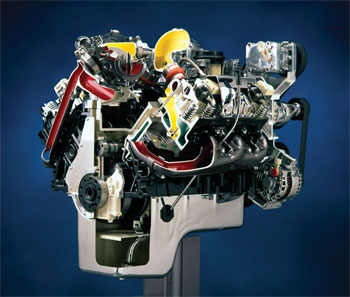 Diesels are up to 30% more efficient than gasoline engines because they use high compression to ignite the fuel rather than spark plugs. High-pressure fuel injectors spray fuel directly into the combustion chambers when the pistons near top dead center. The heat of compression, combined with residual heat in the piston and cylinder head from the previous power stroke, ignites the fuel.
Diesels are up to 30% more efficient than gasoline engines because they use high compression to ignite the fuel rather than spark plugs. High-pressure fuel injectors spray fuel directly into the combustion chambers when the pistons near top dead center. The heat of compression, combined with residual heat in the piston and cylinder head from the previous power stroke, ignites the fuel.
The only drawback with this approach is that a diesel can be hard to start when the engine is cold. Since there is no residual heat in a cold engine, some means of supplemental heat must be provided to make cold starting easier, especially when the outside temperature drops below freezing. Without this supplemental heat to get the fire going, the engine may not start at all. It will just crank and blow white smoke (unburned fuel vapor) out of the tailpipe.
The supplemental heat source for cold starting most passenger car and light truck diesel engines is the glow plug system. Some truck diesel engines use an electrically heated grid in the air intake system to provide start-up heat, but for now, glow plugs are still the primary aid for cold-starting most diesel engines.
 The Powerstroke glow plug system consists of a glow plug control relay (GPC) for 49 states or glow plug control module (GPCM) on 1999 and newer California emissions vehicles, eight glow plugs, a “wait to start” light, related wiring and the powertrain control module (PCM) to operate the system.
The Powerstroke glow plug system consists of a glow plug control relay (GPC) for 49 states or glow plug control module (GPCM) on 1999 and newer California emissions vehicles, eight glow plugs, a “wait to start” light, related wiring and the powertrain control module (PCM) to operate the system.
The “wait to start” light is independent of the actual glow plug on time. The PCM will turn on the “wait to start” light just for three to five seconds to allow sufficient cylinder temperatures to be reached for ease in starting. However, even though the light is off, the PCM will keep the glow plugs energized for a much longer time to reduce smoke and to improve cold driveability. The amount of on time can be as long as 180 seconds, and is determined by the PCM based on inputs from the barometric pressure sensor, the engine oil temperature sensor and available battery voltage.
Symptom: Hard start caused by the glow plug. To diagnose (the following applies to 49 states only):
1. Make sure the battery is fully charged.
2. At the GPC, located on the right valve cover, verify B+ at the battery feed wire. This is a large diameter wire, usually black/yellow or black/orange.
3. If OK, use a volt ohmmeter to check for vehicle power to the GPC on the smaller red wire with key on, engine off (KOEO).
4. If OK, have someone cycle the key off and on, while you check the other small wire (generally pink/orange) for less than 0.5 volts. This is the control wire the PCM grounds for 30 to 180 seconds to energize the GPC relay. If the circuit is being grounded, an audible click should be heard confirming activation of the relay.
5. If no sound is heard, touch a standard 12-volt test light to the output terminal of the relay containing the two large brown wires (some later vehicles and California models will likely have one brown wire and one yellow wire) and check for voltage. If there is no voltage present, replace the GPC relay. If the voltage is OK, perform a voltage drop across the battery feed and output terminals of the relay by cycling the key off and on, and replace any GPC that exceeds a 0.5 volt drop across the contacts.
6. If the GPC checks OK, turn off the key and allow the glow plugs to cool.
Testing the actual glow plug operation requires more than a simple resistance test and presence of B+ at the components.
Note: Testing should be done using any device containing a high current inductive amp clamp.
1. Place the high current inductive amp clamp around the two output wires of the GPC.
2. While turning the key on, watch for the initial draw to read 160 amps or greater. Depending on the manufacturer, glow plugs will draw 17 to 26 amps each, with a minimum recommended draw of 20 amps (20 x 8 = 160). The reasoning behind the minimum specification will be addressed at the end of the article.
3. If the initial surge does not reach 160 amps, move the clamp to each glow plug supply wire at the valve cover connectors, cycle the key on and check for a minimum 20 amps each, replacing any glow plug that does not reach this spec.
4. Allow time to cool between testing each cylinder. On the 1994-’97 trucks, the supply wires will be the brown wires in terminals 1 and 5 of each of the four five-cavity connectors. On the 1999 and newer SuperDuty, the
supply wires will be in terminals 1, 2, 10 and 11 of the two 11-cavity connectors.
Note: The wires on the driver’s side of the engine may be yellow.
California vehicles operate identically to the 49-state systems, but instead of a four-pole relay controlled by the PCM, the glow plug system contains an actual module. This module is in the same location, but has more wires. The output terminal of the 49-state relay has one large wire for each bank that branches off to individual cylinders.
The GPCM has one output wire for each cylinder. As with its 49-state cousin, it still contains the B+ wire, the vehicle power wire and the pink/orange to energize it. It also contains a communication line to the PCM. This module “monitors” individual glow plug draw and reports any errors to the PCM. It can flag a code P0670 if there is a control line fault, a P0683 if the diagnostic circuit is faulty and any combination of P0671 through P0678 for a glow plug fault in cylinders 1-8.
The reason behind the minimum spec mentioned above is that since this module monitors actual current to each cylinder, the MIL will illuminate and a code will be generated for any glow plug that draws less than 20 amps, even though no starting issues are present.
Source: Identifix











